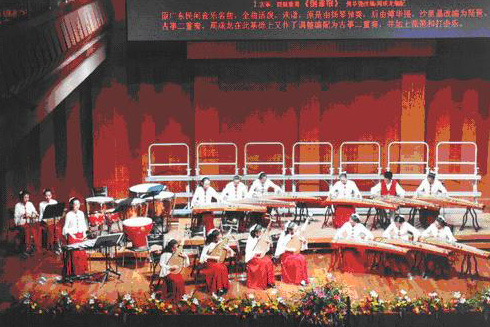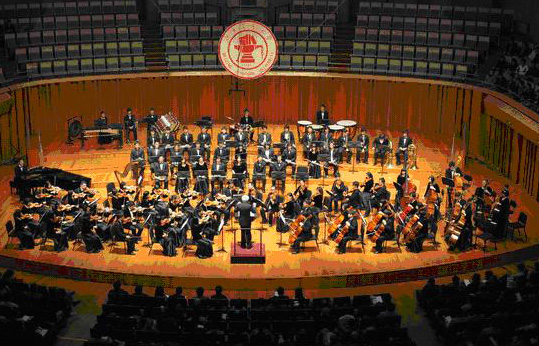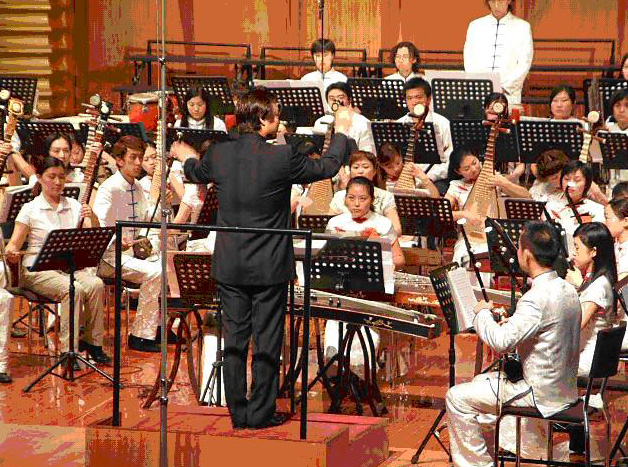
LISS 2013 will be held in conjunction with ICEIS 2013 and ENASE 2013
Registration to LISS allows free access to the ICEIS and ENASE conferences (as a non-speaker)

LISS 2013 will be held in conjunction with ICEIS 2013 and ENASE 2013
Registration to LISS allows free access to the ICEIS and ENASE conferences (as a non-speaker)
1. 民乐合奏《喜洋洋》 Folk Music Ensemble“Jubilance”
2. 民乐合奏《彩云追月》Folk Music Ensemble“caiyunzhuiyue”
3. 京胡与乐队《京调》 Jinghu and Orchestra “Beijing Melody”
4. 笛子与乐队《牧民新歌》Flute and Orchestra“The song of Herdsmen”
5. 二胡齐奏《战马奔腾》Erhu Ensemble “Zhanmabengteng”
6. 琵琶合奏《阳春白雪》 Pipa Ensemble “Spring Snow”
7. 二胡与乐队《二泉映月》Erhu and Orchestra “Er Quan Ying Yue”
8. 民乐合奏《瑶族舞曲》Folk Music Ensemble “Yaozuwuqu”
9. 民乐合奏《牧马少年》Folk Music Ensemble “Wrangler Junior”
10. 民乐合奏《丰收之歌》Folk Music Ensemble “Song of Harvest”
1. Folk Music Ensemble“Jubilance”
" Jubilance " is a famous Chinese music, full of festive atmosphere and lively rhythm.
2. Folk Music Ensemble “Caiyunzhuiyue”
"Caiyunzhuiyue " indicates a picture of the night sky. There is some glorious month, the moon as water, crystal clear. "Chasing " given to the screen to the buzz, Medium hazy with some lively. You light the night background, the cloud-by-month phase, which Contrast each other very interesting.
3. Jinghu and Orchestra “Beijing Melody”
"Beijing Melody " is transferred from Beijing Opera and West flowing tone. Bamboo flute music with crisp bright lead player, accompanied by light accompaniment Silent smooth, unique idea, showing a cheerful and happy, lively atmosphere.
4. Flute and Orchestra“The song of Herdsmen”
"The song of Herdsmen " with the material comes from folk tones of Inner Mongolia, depicting a vast prairie wide, blue sky, the cattle and sheep flocks, pastoral scenes of joy riding a horse-Benz.
5. Erhu Ensemble “Zhanmabengteng”
"Pentium horses, " using a unique high-difficulty playing skills, perform the cavalry soldiers guarding the border of the moving scene, the theme of rich tonal characteristics of the Mongolian folk melodies, spirited excited tone, rhythm and sonorous, cross-shaped gun Hidetake frontier guards’ image, to express The frontier guards describe love of the motherland and the deep feelings of peace.
6. Pipa Ensemble “Spring Snow”
"Spring Snow" is filled with elegant rhyme, rich and varied skills in the folkloric, which is popular in Chinese traditional music
7.Erhu and Orchestra “Er Quan Ying Yue”
"Er Quan Ying Yue" reflects a blind artist who suffered a bitter and painful emotion, the music shows a unique playing techniques and styles of folk, and the unparalleled deep mood, shows the unique charm of Chinese Erhu art.
8. Folk Music Ensemble “Yaozuwuqu”
Folk dance to the song "Long Drum Dance"as the material way with the orchestra, rich, vivid display of the Yao people in song and dance scenes of jubilation. Music uses beautiful melodies, performing singing and dancing in the living conditions Yao appearance.
9. Folk Music Ensemble “Wrangler Junior”
The song describes the Xinjiang Uygur youth, in the vast grasslands of the scene, shows the vast Xinjiang region, the scenic picture. Uyghur and Tajik music combines the unique artistic style family, and joined the corresponding musical elements, making the music with the grand atmosphere, full of rhythm.
10. Folk Music Ensemble “Song of Harvest”
A familiar European folk song with beautiful melody.

eijing Jiaotong University owns an art troupe with more than 500 students, which divided into six sub-clubs, namely glee club, symphony orchestra, concert band, dance troupe, drama club, folk music group. Since established in June 1991, it gained great achievements in many Beijing and national university competitions and external communication performances, trained a large number of college literary and artistic students. The “Long March Suite” was invited to perform in the Great Hall of the People and Guo An theater, which aroused strong repercussion in the society. The student art troupe and glee club gained two first prizes in the national university student art exhibition competition. In the meantime of obtaining honors constantly, the art troupe takes music, drama and dance as language, participates foreign and domestic culture communication activities and national important performances actively.
This picture shows the art troupe of Beijing Jiaotong Universtiy hold a special performance in National Theatre in the afternoon of April 27th, 2010. It is the first time a university symphony orchestra holds a special concert here.

When discussing Han Chinese music, it is common to distinguish two major styles: northern and southern. The styles correspond to the two major geographical and cultural areas where most Han people live. Although both styles emanate from the general Han Chinese culture, they differ in detail because of environmental conditions. The north is cold, dry, and windy. The hardships of life are reflected in the high-pitched, tense, and agitated style of folk song. The south, on the other hand, has mild weather and much rain. Life seems to be easier, and the folk songs of the south are generally lyrical and gentle in nature. Chinese music today is also influenced by Western musical concepts, which is an inevitable consequence of historical and social change.

1. Musical Styles
The common belief that the Chinese scale is a pentatonic scale (without half steps) is only partly correct. The Han Chinese has at least three forms of a seven-tone scale. They also use various forms of a five-tone pentatonic scale.
Southern Chinese folk songs tend to progress in more conjunct motion and smoother lines and emphasize the intervals of thirds and fifths. Northern melodies tend to progress in more disjunct, angular motion, and emphasize intervals of a fourth. These tendencies in the use of melodies are related to the tonal characteristics of the contrasting dialects of the two areas.
Except in special cases (such as free-rhythm introductions), most Chinese music is in duple rhythm. This fondness for duple rhythm (the Western equivalent of 2/4 and 4/4) can be attributed to the belief in the principle of natural duality (such as the female-male or yin-yang relationship). Chinese rhythm patterns may also reflect the Confucian Zhongyong concept: a “doctrine of the mean” that stresses moderation and balance. However, the weak-beat to strong-beat stresses in Western music are not necessarily used. Triple meter is rare, even in modern folk compositions. Syncopation, on the other hand, is the norm rather than the exception. Chinese instrumental music is traditionally heterophonic if it is performed on more than one instrument or for an instrument and voice. Although Chinese music does not use the triadic, four-part harmonic progressions of Western music, harmony may occur occasionally. In fact, the sheng mouth organ produces fourths and fifths when played in the traditional manner, and some qin and zheng zither passages have two or more pitches sounding together when the musicians pluck two or more strings simultaneously. The Chinese people's fondness for clarity may have prevented them from developing a heavy musical texture.
Perhaps the most intricate aspect of traditional Chinese music, and of much East Asian music, is the use of nuance in instrumental and vocal timbre. Even when playing one instrument, there are minute differences in timbre production of a single tone. Much attention is placed on the production and control of single tones; each tone is regarded as a musical entity. The best example of this is heard in qin zither music.
2. Introduction of Chinese traditional instruments
The classic Chinese Orchestra has four sections: the bowed strings, the plucked strings, the winds, and the percussion.

( 1 ) BOWED STRING INSTRUMENTS:
Erhu :The Erhu has a small body and a long neck. There are two strings, with the bow inserted between them. With a range of around three octaves, it's sound is rather like the violin, but with a thinner tone due to the smaller resonating chamber. In the orchestra they are usually divided into 1st and 2nd parts.
Banhu :This instrument is a variety of the huqin. This is so because it uses a wooden sounding board in the sound box. Also known as the bonghu (clapper huqin) because it was heard in the Bangzi or "clapper operas" of the 17th century.
( 2 ) PLUCKED STRING INSTRUMENTS:
Pipa :The Pipa, also the Lute, resembles the Spanish guitar in some ways, with long finger-nails being cultivated to pluck the strings. With its characteristic pear shape and four gut strings, many techniques and uses have developed, to the point where it may be considered a characteristic of Chinese music.
Guqin:The Guqin, a seven-stringed zither, is the oldest Chinese string instrument with 3000 years of history. In Imperial China, a well-educated scholar was expected to be skilled in four arts: qin, qi, shu, and hua; in other words, the guqin, chess, calligraphy, and painting . Since the Guqin has historically been viewed as the symbol of Chinese high culture, today only less than three hundred people in China can play it. It is a rarity today.
Liuqin :This looks like a smaller version of the pipa and sounds like a mandolin.
Ruan :Also known as the moon guitar, it comes in a variety of different sizes and pitches, and is fitted with four strings.
Yangqin :Coming in a variety of sizes, the Yangqin is a dulcimer played with bamboo mallets. The metallic tone resembles the harpsichord, and the concert model has four octaves.
Guzheng :Also known as the Zheng, this is the Chinese zither. Sizes vary fron 13 to 17 strings and has a range exceeding three octaves tuned to the pentatonic scale.
( 3 ) WIND INSTRUMENTS
Di :The Di, or Di-tz, is the traditional Chinese flute. As only three keys can be played accurately on traditional instruments, most players carry a chromatic set. It can have a membrane over an extra tone hole to give the characteristic rattle effect, although some compositions call for this to be omitted.
Bawu :This beautiful instrument will occasionally appear in orchestral wind sections. It is a flute-like pipe with a free reed in the mouth piece.
Suona :This is a reed instrument with a conical metal bell. It has a nasal penetrating sound and comes in various sizes.
Sheng :This is one of the oldest varieties of Chinese instruments, and consista of a bundle of between 17 to 36 pipes seated on a small wind chamber. A free brass reed is placed in the root of the instrument. Coming in soprano, alto, and tenor models, they have a great clarity of tone, and compensate for the lack of brass in tutti orchestration.
Guan :This is a cylinder fitted with a reed mouthpiece. It has a nasal sound quality and generally comes in a variety of sizes.
(4) PERCUSSION INSTRUMENTS:
Gongs and Drums :Like many other oriental musical ensembles, the classic Chinese orchestra uses a wide variety of percussion. Some examples are the Paigu, which is a set of seven, small, tuned drums, together with drums of all pitches and sizes. Used are the yunlo (tuned gongs), quings (tuned bronze bowls), and the jingluo, a small gong used in Beijing opera. This last is recognizable for its characteristic rising tone. Also used are cymbals, gongs, bells and hand bells, wooden bells and hand clappers, claves and temple blocks.
3. Tradition and Folk Songs
The Chinese themselves consider the northern style more dynamic and energetic and the southern style softer and more graceful. All of these characterizations are oversimplified, as the dynamics in Chinese music actually vary according to the nature of the musical genres and instruments.
The classical music of Confucian scholars, such as qin zither music and lyric songs, is naturally soft. Players of pipa lute music are capable of expressing a full range of dynamics. Music for the suona is loud and piercing because of the instrument's construction and its function as an outdoor instrument. Theater orchestra music is loud because it was originally played outdoors in a festive atmosphere. Because of the many factors affecting dynamics in Chinese music, there is no one concept that can adequately describe them.
With the exception of work songs and shange (mountain songs), most Han Chinese folk songs, like most songs in Western folk music, are constructed in strophic form. Chinese folk music, however, uses fewer refrains. Typically, a folk song consists of two or four phrases of equal length; each phrase contains a new musical idea. Two-phrase songs are called “question-answer” songs, and four-phrase songs are “open” (qi), “inheriting” (cheng), “turned” (shuan), and “closed” (he) songs, all of which are terms borrowed from literary writing techniques. Much of Chinese opera music is based on a more complex melodic and rhythmic motivic system called Banqian.
Of all the instrumental forms of Chinese music, the most popular are suites and variations. These forms are not, however, entirely equivalent to their Western counterparts. A Chinese suite is a series of musical movements that are loosely connected. These movements may be independent selections that do not have an apparent melodic or rhythmic relationship, or they may be related for programmatic reasons.
A major characteristic of Chinese instrumental variations is the use of identification motives called the hetou (refrain head) or hewei (refrain tail) that appear in the beginning and end of each movement. Again, except for these refrain motives, there might be no other relationship between the variations and the refrains or among the variations themselves. Sometimes, a movement appears several times among the other movements in a suite; this is considered a variation technique. Due to Western influence, ABA form has become extremely popular in modern instrumental folk music.
The Chinese have traditionally shown a fondness for extra-musical connotations, so Program music, poetic titles, and descriptions of compositions are popular. The existence of a sophisticated literary class is responsible for shaping this tradition, which is found not only in old music but also in modern socialist and so-called revolutionary work.